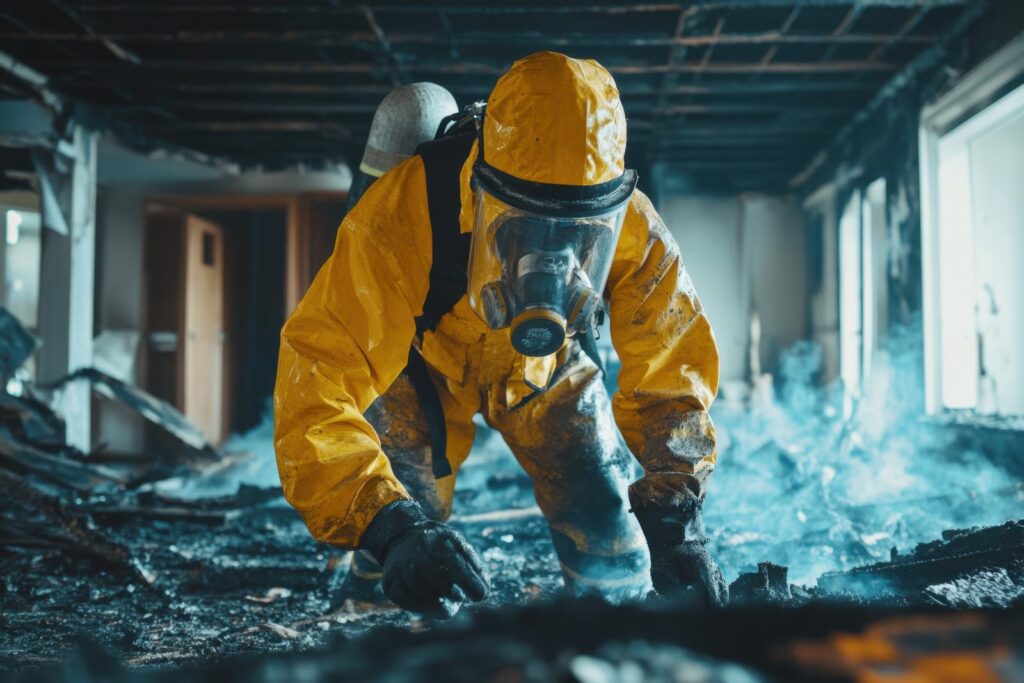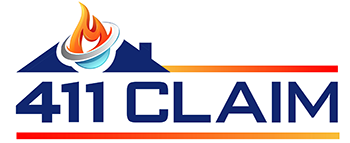
Contents
When faced with fire damage, it’s vital to approach cleanup methodically. Start by evaluating the extent of the damage and ensuring your safety. You’ll need to document everything for insurance purposes. It’s not just about cleaning; it’s about restoring your property effectively. Understanding these essential steps can make a significant difference in the outcome. But where do you begin, and what specific actions should you take next?
Key Takeaways
- Assess and document the damage with photos and inventory for insurance claims and recovery planning.
- Ensure safety by evaluating hazards and using protective gear before entering the property.
- Remove debris carefully, categorizing items as repairable or beyond repair, and follow safety protocols.
- Clean and disinfect affected areas thoroughly to eliminate soot, bacteria, and odors, maintaining good ventilation.
- Engage professionals for restoration and preventive measures to safeguard against future incidents and preserve property value.
Assessing the Damage
When you face the aftermath of a fire, the first step is to thoroughly assess the damage.
Begin by documenting everything: take clear photos of affected areas, noting the extent of the destruction. This damage assessment is essential for your records and will support your insurance claims. You’ll want to categorize the damage—structural, contents, and personal items—so you can discuss it clearly with your insurance agent.
Next, make a list of damaged items, including their estimated value. This detailed inventory will help you navigate the claims process more smoothly.
Remember, your insurance policy may have specific requirements for reporting damages, so familiarize yourself with those details.
Ultimately, being methodical in your assessment not only aids in your insurance claims but also helps you move forward in the recovery process, restoring a sense of normalcy and belonging in your life.
Ensuring Safety
After evaluating the damage, ensuring safety becomes your top priority. Before you begin any cleanup, assess the scene for hazards like structural damage, exposed wires, or lingering smoke.
Always prioritize fire safety; if there’s any doubt about the building’s stability, don’t enter. Equip yourself with personal protective equipment—this includes gloves, masks, and goggles. These items shield you from toxic debris and harmful particles that may still linger in the air.
If you notice any signs of hazardous materials, such as chemicals or asbestos, avoid touching them and consider evacuating the area. Remember, your well-being is essential during this process.
Share your safety plans with family or friends, so they know what steps you’re taking. By following these guidelines, you create a safer environment for yourself and anyone involved in the cleanup, fostering a sense of community and support in a challenging time.
Contacting Professionals
When it comes to fire damage cleanup, contacting professionals is essential for effective restoration.
Their expertise confirms that you assess the damage accurately and address all underlying issues.
Choosing reliable services not only speeds up the recovery process but also assures that your property is treated safely and efficiently.
Importance of Expertise
While you might feel tempted to tackle fire damage cleanup on your own, contacting professionals is essential for guaranteeing thorough and safe restoration.
Experts in fire restoration bring a wealth of knowledge and experience that can make a significant difference. They conduct an expert evaluation, identifying hidden damage that you might overlook, such as structural issues or toxic residues.
Their specialized tools and techniques guarantee that every aspect of the cleanup is handled appropriately, reducing the risk of further damage or health hazards.
Assessing Damage Properly
Properly evaluating fire damage is essential, and enlisting professionals is the best way to guarantee an accurate evaluation.
Experts utilize advanced damage evaluation techniques to thoroughly assess the extent of destruction. They conduct a detailed fire impact analysis, considering structural integrity, smoke damage, and potential hidden hazards.
By relying on their knowledge, you ascertain that every affected area is examined meticulously, minimizing the risk of overlooked damage.
Professionals also provide a detailed report, giving you clarity on what needs addressing. This step not only safeguards your property but also offers peace of mind, knowing you’re part of a community that values safety and resilience.
Choosing Reliable Services
How can you guarantee you’re selecting the right professionals for fire damage cleanup? Start by researching service reviews.
Look for companies with positive feedback that highlight their expertise and customer satisfaction. This helps you feel confident in your choice.
Next, request cost estimates from multiple services to understand the price range and assure transparency. A reliable company will provide a detailed breakdown of their charges, helping you avoid hidden fees.
Don’t hesitate to ask about their experience with fire damage specifically. A knowledgeable team will guide you through the process, assuring your home is restored safely and efficiently.
Securing the Property
Once you’ve contacted professionals, it’s essential to secure the property to prevent further damage.
Start by evaluating the structural integrity of your home, as compromised walls or ceilings can pose serious risks.
Next, contain any hazardous materials to guarantee safety while you work on restoring your space.
Assessing Structural Integrity
As you begin the fire damage cleanup process, evaluating the structural integrity of your property is essential to guarantee safety and prevent further damage.
Start with thorough structural inspections, focusing on walls, ceilings, and floors. Look for signs of warping, cracks, or instability.
Next, conduct safety evaluations to assess the risks of collapsing structures or hazardous materials.
If you’re unsure about any findings, consult a professional engineer or contractor who specializes in fire damage restoration. They can provide insight and guidance tailored to your situation.
Remember, ensuring your home’s stability not only protects you but also brings peace of mind as you navigate this challenging time.
Prioritize safety to facilitate a smooth and effective recovery process.
Containing Hazardous Materials
After confirming the structural integrity of your property, the next step is to focus on containing hazardous materials that may have been released during the fire.
It’s vital to identify any hazardous waste, such as charred materials, chemicals, or burnt plastics, that could pose health risks.
Begin by wearing appropriate personal protective equipment (PPE) to safeguard yourself.
Follow established safety protocols, including isolating affected areas and using proper containment methods to prevent contamination.
If you encounter large amounts of hazardous waste, consider hiring professionals trained in hazardous material cleanup.
They’ll guarantee that the waste is disposed of safely and in accordance with local regulations.
This meticulous approach not only protects your health but also helps secure your property’s future.
Preventing Further Damage
To effectively prevent further damage to your property, securing the premises is vital immediately following a fire. This not only protects your belongings but also aids in damage mitigation. Start by boarding up windows and doors to deter trespassers. Utilize tarps to cover any exposed areas of the roof. It’s important to document everything for insurance purposes, so take photos before making repairs. Contact professionals who specialize in fire prevention to assess the situation thoroughly.
| Action | Purpose | Tools Needed |
|---|---|---|
| Board up openings | Prevent theft and weather damage | Plywood, screws |
| Cover roof areas | Mitigate further exposure | Tarps, ropes |
| Document damage | Support insurance claims | Camera, notebook |
| Notify utility companies | Guarantee safety and prevent hazards | Phone |
| Engage restoration experts | Start the recovery process | Contact list |
Removing Debris and Salvaging Items
Removing debris and salvaging items after a fire is essential for restoring your property and ensuring safety. Start by evaluating the damage; identify hazardous materials like broken glass or charred wood. Wear protective gear, including gloves and masks, to safeguard yourself during debris removal.
Next, categorize items based on their condition—some may be beyond repair, while others might be salvageable. For those worth saving, document each piece to assist with insurance claims and item restoration. Clean and dry these items carefully, as smoke and water can cause further damage.
Consider involving professionals for large-scale debris removal, as they’ve the expertise and equipment to handle the job efficiently.
Finally, remember that salvaging items isn’t just about physical restoration; it’s about reclaiming a sense of belonging and normalcy in your life after the fire. This process lays the foundation for rebuilding your home and spirit.
Cleaning and Disinfecting Affected Areas
Once you’ve dealt with debris and salvaged your belongings, it’s vital to focus on cleaning and disinfecting the affected areas. Start by using appropriate cleaning techniques, such as vacuuming to remove soot and debris. Follow up with a thorough wash of surfaces using soapy water or specialized cleaners.
Next, employ effective disinfecting methods to kill any lingering bacteria or odors. You can create a solution of bleach and water or use commercial disinfectants. Maintain good ventilation while working to avoid inhaling harmful fumes.
Here’s a quick reference table to guide your cleaning and disinfecting process:
| Cleaning Technique | Disinfecting Method |
|---|---|
| Vacuuming | Bleach solution (1:10 ratio) |
| Soap and water wash | Commercial disinfectant |
| Steam cleaning | Hydrogen peroxide solution |
Addressing Water Damage
After addressing the soot and debris from the fire, you may encounter water damage due to firefighting efforts.
It’s important to act quickly to mitigate further issues. Start with water extraction to remove standing water; this is vital in preventing mold growth. Use a wet/dry vacuum or hire a professional service to guarantee thorough removal.
Once the water is extracted, focus on drying out the affected areas. Open windows and use fans or dehumidifiers to speed up the process.
Pay close attention to hidden spaces, like behind walls and under floors, where moisture can linger.
Mold prevention is significant at this stage. Consider applying antimicrobial treatments to surfaces that were exposed to moisture.
Regularly inspect the area for any signs of mold growth, as early detection is key. Taking these steps will help you safeguard your property and promote a healthier environment.
Restoring and Repairing the Property
Restoring and repairing your property after fire and water damage is an essential step in the recovery process. Start by evaluating the extent of the damage; this will guide your fire restoration techniques.
Focus on removing debris and soot, as these can lead to further deterioration if left unchecked.
Next, address structural issues, ensuring that the framework is sound. You might need to replace drywall, flooring, or roofing materials that have been compromised. It’s vital to use materials that match your home’s original aesthetic for seamless integration.
Don’t forget to clean and restore your personal belongings, as this contributes to property value preservation. Utilize professional services if necessary, as they’ve specialized equipment and expertise.
Finally, consider preventive measures, such as installing fire-resistant materials, to safeguard your home against future incidents. This methodical approach not only restores your space but also fosters a sense of belonging and security.
Wrap-Up
As you stand amidst the charred remnants of your home, each step you take toward cleanup brings hope and renewal. By evaluating damage, ensuring safety, and enlisting professionals, you’re not just restoring your property; you’re reclaiming your peace of mind. Picture the fresh scent of new beginnings as you clean and disinfect, and envision the vibrant restoration ahead. With diligence and care, you’ll transform ashes into a resilient foundation for a brighter future.
Recent Posts
Pricing Insights for Damage Restoration Services
When unexpected events disrupt your life, steering through the costs of damage restoration can feel
Budgeting for Blaze Cleanup: A Trusty Guide
Budgeting for blaze cleanup is like steering through a maze—complex and overwhelming but attainable with
Top Storm Damage Repair Techniques for Homeowners
When storms release their fury, the aftermath of storm damage can feel overwhelming, much like
